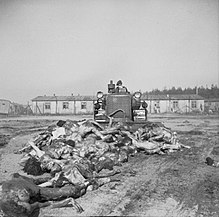Death Mills
This article needs additional citations for verification. (February 2015) |
| Death Mills | |
|---|---|
Death Mills | |
| Directed by | Billy Wilder Hanuš Burger |
| Written by | Hanuš Burger |
| Edited by | Billy Wilder (supervisor) |
| Distributed by | United States Department of War |
Release date |
|
Running time | 22 minutes |
| Countries | United States Germany |
| Languages | English German |
Death Mills (or Die Todesmühlen) is a 1945 American-German propaganda film directed by Billy Wilder and produced by the United States Department of War. The film was intended for German audiences to educate them about the atrocities committed by the Nazi regime. For the German version, Die Todesmühlen, Hanuš Burger is credited as the writer and director, while Wilder supervised the editing. Wilder is credited with directing the English-language version; however, he later said that he didn't direct anything as "there was nothing to direct".
The film is a much-abbreviated version of German Concentration Camps Factual Survey, a 1945 British government documentary that was not completed until nearly seven decades later.[1]
The German-language version of the film was shown in the US sector of West Germany in January 1946.[2]
Synopsis

The film opens with a note that the following is "a reminder that behind the curtain of Nazi pageants and parades was millions of men, women and children who were tortured to death – the greatest mass murder in human history," then fades into German civilians at Gardelegen carrying crosses to the local concentration camp.
Most of the film includes footage of the newly liberated camps over a score of stark classical music. The narrator notes that people of all nationalities were found in the camps, including people of all religious or political creeds. There is no mention of the particular fate of
The Orson Welles film The Stranger uses footage of this film during the scene where Edward G. Robinson explains to Mary about Franz Kindler's responsibility for the Holocaust. This film would be included as a supplement on the Kino Lorber Blu-Ray of The Stranger.[3]
Concentration camps
The images from the camps include shots of piles of skeletal corpses, naked skeletal survivors (often supported by fellow prisoners) together with footage of prosperous-looking German citizens being forced to observe their suffering. Some are also forced to carry the corpses to be buried, although most of this work was usually carried out by ex-camp guards (as at
There are shots of mass graves, as well as of individual burials, as at
Lastly, the film shows the piles of stolen personal belongings of gassed victims, filmed by the Soviets when they liberated
See also
- German Concentration Camps Factual Survey
- List of Holocaust films
- The Nuremberg Trials – Soviet film about the Nuremberg trials
- That Justice Be Done – American film about the Nuremberg trials
References
- ^ Jeffries, Stuart (9 January 2015). "The Holocaust film that was too shocking to show". The Guardian. Retrieved 1 February 2015.
- ISBN 1904764517. Retrieved 3 February 2015.
- ^ "The Stranger Blu-ray". Retrieved 2022-05-30.
External links
- The short film Death Mills (english version) is available for free viewing and download at the Internet Archive.
- Die Todesmühlen at IMDb
- Complete film at US Holocaust Museum
- The Death Mills at AllMovie
